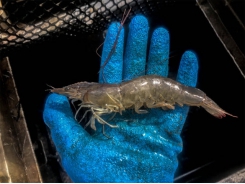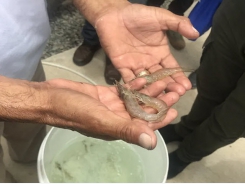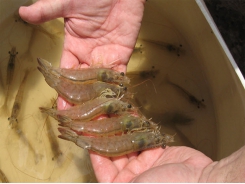Emerging disease: Shrimp Hemocyte Iridescent Virus (SHIV)

Virus causing serious mortalities in Pacific white shrimp in China
Clinical symptoms of L. vannamei challenged with the potential iridescent virus compared with those of the control group. (a) External appearance of the shrimp.
A newly discovered iridescent virus that causes severe disease and high mortality in farmed Pacific white shrimp (Litopenaeus vannamei) in Zhejiang, China, has been verified and provisionally named as shrimp hemocyte iridescent virus (SHIV). This article summarizes the original publication (DOI:10.1038/s41598-017-10738-8).
Editor note: There are 12 co-authors in this study but we only list the corresponding one. Please consult the original publication for names and affiliations of all co-authors.
Background
In recent years, epizooties (localized outbreaks) of infectious diseases in farmed L. vannamei have caused massive economic losses in China. SHIV was first detected and identified in samples of pond-farmed L. vannamei (2 to 3 cm) collected from a farm in Zhejiang Province, China, in December 2014. Affected animals experienced massive die-offs and exhibited hepatopancreatic atrophy with fading color, empty stomach and guts and soft shells. Results of testing with polymerase chain reaction (PCR) techniques showed that samples were negative for various known shrimp viruses, including WSSV, IHHNV, VPAHPND, YHV and TSV11.
Also, results of an epidemiological survey indicated that this might not be the first outbreak at this farm. A total of 89 out of 575 L. vannamei individuals, 5 out of 33 Chinese white shrimp (Fenneropenaeus chinensis) individuals, and 5 out of 10 giant freshwater prawns (Macrobrachium rosenbergii) individuals tested SHIV-positive in samples collected during 2014 to 2016 in 20 counties of five provinces over China, raising the concern that the virus may have widely spread to surrounding shrimp farming areas.

(b) Section of hepatopancreas.
Jie, SHIV, Table 1
| Shrimp species | Negative | Positive | Total | Positive rate |
| L. vannamei | 486 | 89 | 575 | 15.5% |
| F. chinensis | 28 | 5 | 33 | 15.2% |
| Mb. rosenbergii | 5 | 5 | 10 | 50.0% |
| Mp. japonicas | 7 | 0 | 7 | 0.0% |
| TOTAL | 526 | 99 | 625 | 15.8% |
Table 1. Test results for SHIV using nested PCR in several shrimp species.
The clinical symptoms of SHIV infection include slight loss of color on the surface and cut of hepatopancreas, empty stomach and guts, soft shell in partially infected shrimp and slightly reddish body in one-third of individuals. These symptoms are not similar to those caused by the infection with other alleged iridovirus in other species of penaeid shrimp, sergestid shrimp or freshwater lobsters.
Histological sections revealed that the disease might be caused by a suspected viral infection with obvious pathogenic symptoms, which did not match the histopathologic characteristics of infection with any known viruses or acute hepatopancreatic necrosis disease (AHPND). Using high-throughput DNA sequencing technologies, we determined that a potential iridescent virus was present in one sample, and that the phylogenetic analysis of the two proteins did not support this iridescent virus – provisionally named as shrimp hemocyte iridescent virus (SHIV) – as belonging to any known genus of family Iridoviridae.
Challenge tests and histopathological examination
We conducted challenge tests via invasive intramuscular injections or non-invasive mode including reverse gavage or per os infection that could successfully pass a filterable infectious agent from the diseased L. vannamei to healthy animals, and caused similar gross clinical symptoms and pathological changes, proving that this virus is the causative agent of the disease.

Fig. 1: Cumulative mortalities of L. vannamei in experimental infections. Two groups of shrimp were challenged with a filtrate of tissue extracts by either intermuscular injection (im) or anal reverse gavage (rg). Another group of shrimp was challenged via per osinfection (per os). The control groups were treated in the same way with PPB-His buffer in group im (c) and group rg (c), respectively, or fed with shrimp feed in group per os (c). Cumulative mortalities are shown as means of data from three replicates for each experimental group (each replicate included 30 individuals).
We also we used In Situ Hybridization (ISH) with a specific probe to detect SHIV in sections of infected L. vannamei. In situ hybridization (ISH) is a molecular technique that shows the location of specific nucleic acid sequences in tissues or on chromosomes – this is a critical stage to understand the regulation, organization and function of genes.
The probe reacted to the histological lesions in hematopoietic tissue and hemocytes in gills, hepatopancreas and periopods obtained from a sample, as well as in tissues from the challenge experiment described in this study. Our results fulfilled Rivers’ postulates – created in 1973 by Thomas M. Rivers to establish the role of a specific virus as the cause of a specific disease – for the demonstration of a viral etiology.


Fig. 2: ISH using a digoxigenin labeled 279 bp probe for the shrimp hemocyte iridescent virus on histological sections of L. vannamei. (a)–(d) hematopoietic tissue, gills, hepatopancreas and periopods in SHIV-positive sample, respectively; (e)–(h) hematopoietic tissue, gills, hepatopancreas and periopods in SHIV-negative sample, respectively. In (a)–(d), blue signals were observed in the cytoplasm of the hemocytes of hematopoietic tissue, gills, sinus of hepatopancreas and periopods. In (e)–(h), no hybridization signal was seen on the same tissues of SHIV-negative L. vannamei except some non-specific signals on cuticle. Bar, 10 μm (a and b), 20 μm (c and d) and 50 μm (e–h), respectively.
Histopathological examination of sample tissues revealed basophilic inclusions and pyknosis in hematopoietic tissue and hemocytes in gills, hepatopancreas, periopods and muscle. Using the technique of viral metagenomics sequencing (from genetic material recovered directly from environmental samples), we obtained partial sequences we interpreted as potential iridoviridae. And phylogenetic analyses using amino acid sequences of major proteins revealed that it is a new iridescent virus but does not belong to the five known genera of Iridoviridae.

Fig. 3: Histopathological features of Davidson’s alcohol-formalin-acetic acid (AFA) fixed L. vannameiin sample 20141215 (a, c, e and d). Black arrows show the basophilic inclusions while white arrows show the karyopyknotic nuclei. (a) Haematoxylin and eosin (H&E) staining of the hematopoietic tissue; (b) H&E staining of gills; (c) H&E staining of the sinus in hepatopancreas, and (d) H&E staining of periopods. Bar, 10 μm.
After having compared the morphological, physiological and phylogenetic characteristics of our samples with those of other iridescent viruses, we temporarily assign the etiological agent as shrimp hemocyte iridescent virus (SHIV), which could cause shrimp hemocyte iridescent virus disease (SHIVD). We suggest a new genus of Iridoviridae, Xiairidovirus, which means shrimp iridescent virus.
Perspectives
Through isolation, reinfection and histopathological characterization, we have revealed that SHIV is a new virus in family Iridoviridae and a pathogen of L. vannamei. We have additionally developed an ISH assay and a nested PCR method for the specific detection of SHIV.
The findings of our study emphasize the need for professionals well prepared in aquatic animal health and experienced farmers in the shrimp aquaculture industry to pay closer attention to SHIV and to take more effective measures for preventing the disease outbreaks and economic losses caused by SHIV.
Có thể bạn quan tâm
Phần mềm

Phối trộn thức ăn chăn nuôi

Pha dung dịch thủy canh

Định mức cho tôm ăn

Phối trộn phân bón NPK

Xác định tỷ lệ tôm sống

Chuyển đổi đơn vị phân bón

Xác định công suất sục khí

Chuyển đổi đơn vị tôm

Tính diện tích nhà kính

Tính thể tích ao hồ




 Use algorithms to calculate feed for Pacific white…
Use algorithms to calculate feed for Pacific white…  New nested PCR test targets gene specific to…
New nested PCR test targets gene specific to…